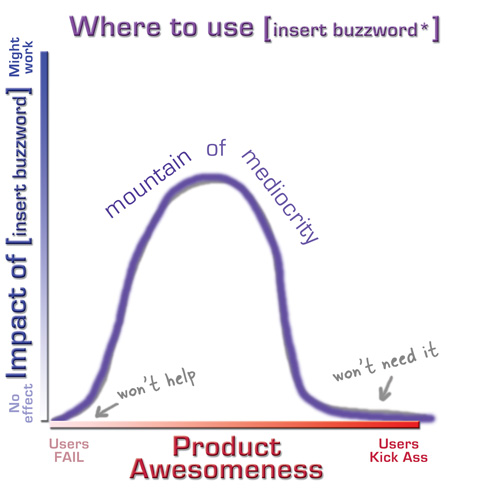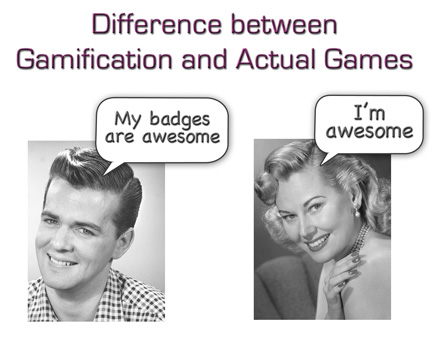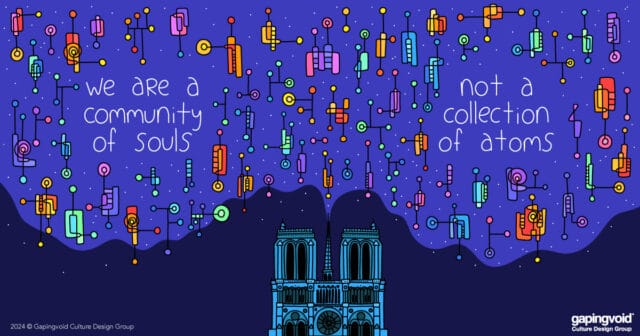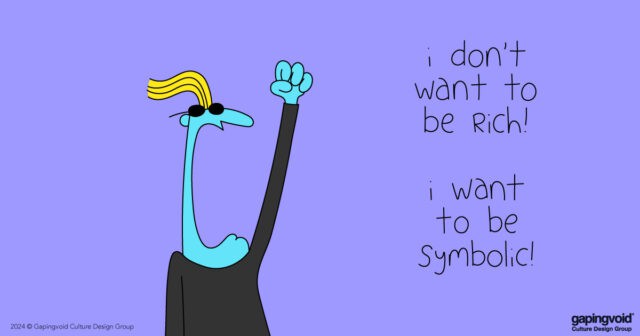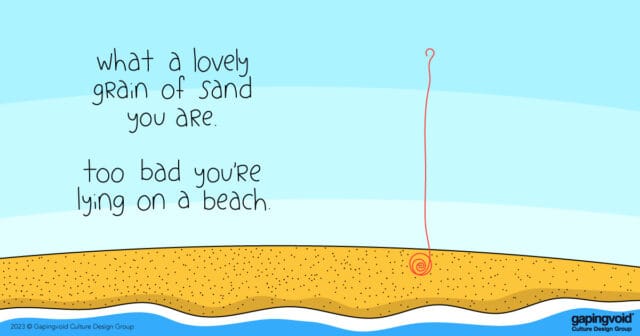[NB: Today’s guest post is by the world’s most famous ex-blogger, the great Kathy Sierra.]
We’re always searching for that secret formula, that magic pixie dust to sprinkle over our products, services, books, causes, brands, blogs to bring them to life and make them Super Successful. Most marketing-related buzzwords gain traction by promising pixie dust results if applied to whatever it is we make, do, sell. “Add more Social!”. “Just need a Viral Video!” “It’s about the Storytelling!”. “Be Authentic!”
The rise of social networking and media opened up a world of new possibilities, yet most Marketing 2.0 is basically:
“If you cannot out-spend the competition, you can out-friend them!” He who has the most Facebook fans, Twitter followers, and blog commenters Wins! It’s all about Social Capital now!
Sure, you can try that. You can work your ass off to be, as one marketer put it, “the person your customers want to party with.”
I never understood how any of this made sense, given that very little of what I see “brands” (or their human spokestweeters) do on social media is changing the fundamental nature of how users interact with their products. “But that is not the point! It is about being human!”. Nope, I still don’t get it. Why would anyone want to compete on *that*? It felt fragile to be in essentially a marketing arms-race of who-is-the-most-engaging-social-media rock star. What does that really have to do with what users do with the product?
And I saw examples over and over of social media rock stars with tons of followers, yet they were not able to convert those followers into Actual Paying Customers unless the product was what people really wanted. Being super-friendly, “liked”, etc. has limits when it comes to *paying*. I will follow your blog, but no matter how awesome I think YOU are, I won’t be paying for your book unless I think it’ll make ME a little more awesome.
So, why are people still so convinced that social media and all related buzzwords are The Answer? It has always appeared that if the product is truly crap, “your social media strategy won’t save you.” Even the social media gurus agree on that one. But it seems the opposite end is true as well… If the product makes the users awesome (at whatever the product is helping them do), no special secret magic pixie dust sauce is needed either.
Oh, social media does play a massive role in the success of a product that people love, but it is not the product-to-users “engagement” that matters, it is users-to-users (and users-to-potential-users). If people love what a product, book, service let’s them *do*, they will not shut up about it. The answer has always been there: to make the product, book, service that enables, empowers, MAKES USERS AWESOME. The rest nearly always takes care of itself.
Which brings me back to, why are so many so convinced that [insert favorite buzzword] is the answer vs. just making a product that helps people kick ass in a way they find meaningful?
And then someone I trust said this: these [insert favorite new buzzword] approaches are not about saving a crap product or marketing an awesome one… where these tools really DO make a difference for a brand is when the brand has little or no other compelling benefit over the competition. If the product is mediocre, or even really good but with too many equally good competitors, these things can make a difference. If you have little else to compete on, then out-friending/out-viraling/out-gamifying can work.
At least until your competition out-hires a good social media strategist or compelling extroverted social media star and out-friends you.
You do not want to be That Brand. You do not want to be That Product. That Book. That Consultant. You do not want to be in that arms race because it is an exhausting and fragile place to be. You want to use social media not because you *must* but because you can add even more value for your users by doing so. You do not want to be the guy that must ask constantly, “how can I get more comments on my blog? how can I get more followers and fans?”
The real pixie dust is when you ask yourself, “how can I help my users get more comments on THEIR blog?”. You want to be the guy who asks, “How can I help my users get more followers and fans?” And that is why I have always been such a fan of Hugh and Gary V and Tim Ferris, for example. Not for the comments their followers make about Hugh, Gary, and Tim… But for the comments their followers make about themselves. In a nutshell: Hugh, Gary, and Tim might well be the people you want at a dinner party, but what matters is that they help people become more interesting at their OWN next dinner party.
What prompted me to write this is the latest magic pixie dust buzzword, one that I am passionately against: gamification. Applying principles of game design to non-game activities can be done carefully, artfully, and with wonderful results. We use principles of game design in our programming books, for example, and you may have heard me at SXSW talk about using aspects of game mechanics to help create passionate users. But the current crop of “gamification” experts are doing nothing more than “pointsification/badgification”, taking the most superficial, surface mechanics of games and applying them out of context to areas where they are, as I have referred to it, “the high fructose corn syrup of engagement.” Once the sugar-rush novelty has worn off, there will be a substantial crash from the high. And it may be one from a which a brand cannot recover.
Don’t be that brand.
Don’t be that product.
Don’t be that book.
Be the one people talk about NOT because of your latest gamification and WOM campaign, but because it is obvious to your users and those they influence that your brand, product, book has made them better at something. Something they care about. Don’t be the slot machine of your industry. Give people an experience that leaves them feeling a little better about their own capabilities, not better about the faux-status awards they know, in their heart, are not examples of anything more awesome than a marketer’s attempt to use them.
Just make people better at something they want to be better at. When your goals and your user’s goals are truly aligned, you don’t need pixie dust. Don’t out-spend, don’t out-friend, and please don’t out-badge. There is a world of difference between helping someone *appear* more awesome and helping them actually BE more awesome.
-Kathy Sierra

